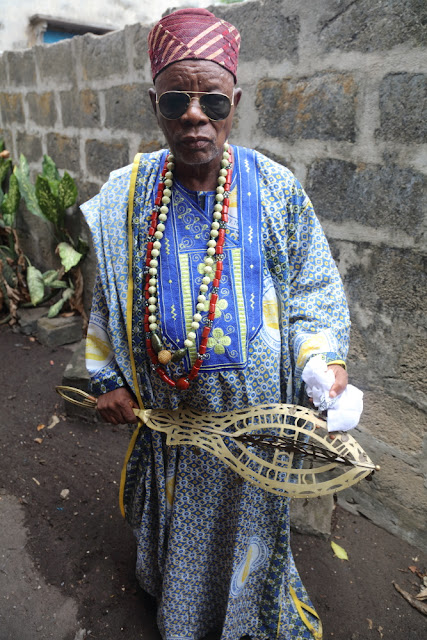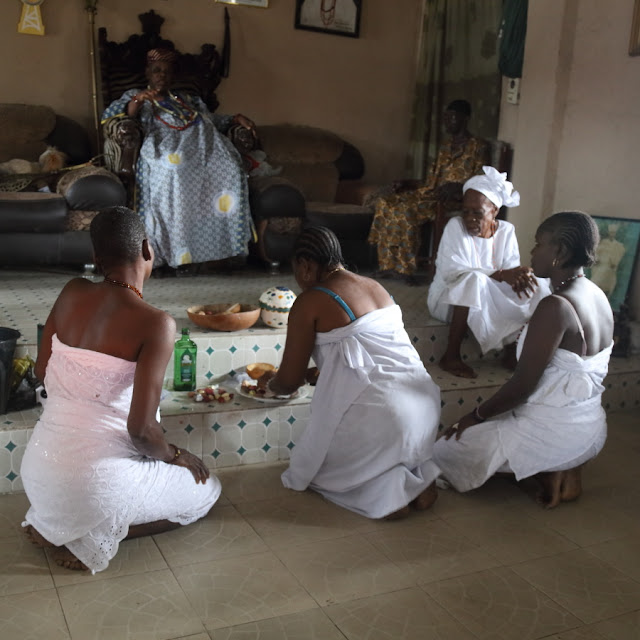 |
| The Wawu of Badagry |
While visiting Badagry, we discovered a city with a lot of heritage, with a particular focus on slave-trade about which three museums are covering. There are a lot for a town of the size of Badagry. The town a good number of buildings of brazilian influence. They were erected by returning slaves after the abolition of slavery. There are also a few colonial buildings such as the house that hosted the British administration and which is overlooking the lagoon. The city also counts several traditional compounds. There is the one of the Akran
, the head of Badagry Kingdom who is referred to as Aholu. He is revered as the Ruler of Badagry. In a different area stands the compound of the Wawu of Badagry. The Wawu family, according to High Chief WAWU, descended from Ile-Ife and settled at Ouidah (Whydah) in Benin Republic. Later the Ifa oracle asked them to return through Gberefu to their present location in Badagry.
The Wawu is famous because his family refused to support slavery at the time that it got banned in the 19th century. He stood up against other clans who wanted to continue engaging in the trade because it was lucrative. In 1843, the British donated him two cannons to support his engagement. The Wawu is also reputedly descending from the Obatala lineage which includes the first Alaafin of Oyo.
 |
| blessing ceremony in the audience hall of the Wawu |
During our visit, led by Anogo James Akeem Osho, the Wawu received us in the audience hall of his palace. He was wearing a large robe of printed african fabric mixing white, blue and yellow motives. He also wore a red Aso-oke hat and two necklaces, one of red coral and the other one of light-green carved beads. He was holding a metallic sceptre in the shape of a tree leaf, to which tiny pieces of metal were connected and able to produce a scintillating sound when being shaken. This sounded like the equivalent of the yoruba prayer bell to materialise important moments or transitions. The Wawu was seating on his throne at one end of the room. A few members of his family where present. One of his wives, one elder, four priestesses dressed with a white piece of cloth. They performed a blessing ritual by making offerings to the gods and interpreting the position of freshly cut kola nuts after throwing them on the ground like dices. Then, the Ifa priest interpreted the oracle for three of us visitors by looking at the position and shape of a new batch of kola nuts. The priestesses ended up the ceremony by songs of the family. After this water, schnapps, bits of kola nuts were offered to the people present in the room to share the blessings. I tried one "alligator pepper", which looks like a grain of black pepper but taste like a chilly with red pepper aroma - actually quite pleasing in contrast to the bitterness of the kola nut.
 |
| the Egungun and the Wawu |
We then moved to a courtyard adjacent to the audience hall, which had shrines dedicated to three separate divinities: Obatala, Osun and Ibeji. The priestesses made offerings to the gods by pouring palm oil, seven up, gin and another white substance over the representations of the gods. Fruits were also served and carrots where shared among the humans. The Egungun of the compound came out from his grove (Igbale Egun) into the courtyard and spoke with the Wawu and other people. He was dressed with game skins, a collection of charms and a red and blue wooden head gear carved with two faces with large white eyes.
We had a look at the cannons given by the British and the place where the Union Jack used to be hoisted over a well.
 |
| 1843, the Union Jack floated on the well |
 |
| the cannons offered by the British to the Wawu in 1843 for the abolition of slavery |





Great Royal Family of Badagry........
ReplyDelete